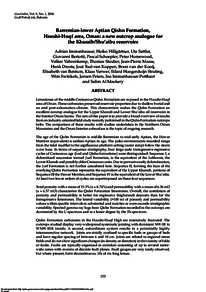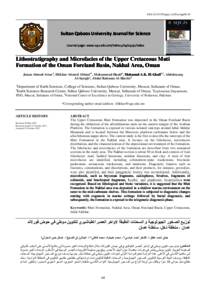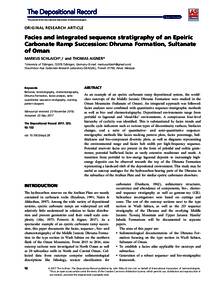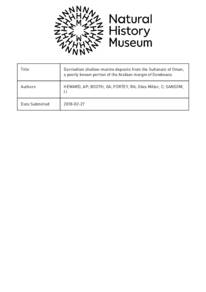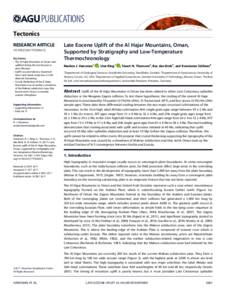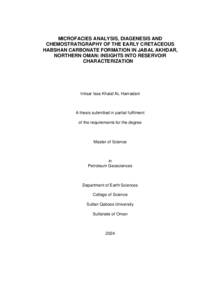وثيقة
Barremian-lower aptian Qishn formation, Haushi-Huqf, Oman : a new outcrop analogue for the Kharaib/Shu'aiba reservoirs.
المعرف
DOI: 10.2113/geoarabia0901153
المصدر
GeoArabia. v. 9, 1, p. 153-194
المساهمون
Hillgärtner, Heiko., مؤلف
Sattler, Ute., مؤلف
Bertotti, Giovanni., مؤلف
Schoepfer, Pascal., مؤلف
Homewood, Peter., مؤلف
Vahrenkamp, Volker., مؤلف
Steuber, Thomas., مؤلف
Masse, Jean-Pierre., مؤلف
Droste, Henk., مؤلف
Koppen, José Taal-van., مؤلف
van der Kooij, Bram., مؤلف
van Bentum, Elisabeth., مؤلف
Verwer, Klaas., مؤلف
Swinkels, Wim., مؤلف
Peters, Jeroen., مؤلف
Al-Maskery, Salim., مؤلف
الدولة
Bahrain.
مكان النشر
Manama
الناشر
Gulf PetroLink.
ميلادي
2004-01-01
اللغة
الأنجليزية
الموضوع
الملخص الإنجليزي
Limestones of the middle Cretaceous Qishn Formation are exposed in the Haushi-Huqf area of Oman. These carbonates preserved reservoir properties due to shallow burial and an arid post-exhumation climate. This characteristic makes the Qishn Formation an excellent outcrop analogue for the Upper Kharaib and Lower Shu'aiba oil reservoirs in the Interior Oman basins. The aim of this paper is to provide a broad overview of results from an industry-oriented field study recently performed in the Qishn Formation outcrops belts. The comparison of these results with studies undertaken in the Northern Oman Mountains and the Oman Interior subsurface is the topic of ongoing research. The age of the Qishn Formation is middle Barremian to mid-early Aptian, the Hawar Member (equivalent) is earliest Aptian in age. The paleo-environments recorded range from the tidal mudflat to the argillaceous platform setting (outer ramp) below the storm wave base. In terms of sequence stratigraphy, four large-scale transgressive-regressive cycles of Cretaceous age (Jurf and Qishn formations) were distinguished. Sequence I, a dolomitized succession termed Jurf Formation, is the equivalent of the Lekhwair, the Lower Kharaib and possibly older Cretaceous units. Due to pervasive early dolomitization, the Jurf Formation is not further considered here. Sequence II, forming the base of the overlying Qishn Formation represents the equivalent of the Upper Kharaib, portions of Sequence III the Hawar Member, and Sequence IV is the equivalent of the Lower Shu'aiba. At least two lower orders of cycles are superimposed on these four sequences. Total porosity with a mean of 19.3% (s = 8.74%) and permeability with a mean of 6.36 mD (s = 6.57 mD) characterize the Qishn Formation limestones. Overall, the correlation of porosity and permeability is better for regressive (highstand) deposits than for the transgressive limestones. The lateral variability (>100 m) of porosity and permeability values within specific intervals is substantial and matches or even exceeds stratigraphic variability. Spectral gamma ray logs from Qishn Formation recorded in the outcrops are dominated by the U spectrum and to a lesser degree by the Th spectrum. Qishn Formation carbonates in the Haushi-Huqf High are extensively fractured. The outcrops studied display very widespread systematic jointing with dominant NW-SE to WNW-ESE trends. A second, subordinate system results in a potentially highly interconnective network. Joints are strictly confined to specific beds or groups of beds and have regular spacing of between 6 and 18 cm. Joints are related to regional stress fields and do not show significant changes (in density or direction) in the vicinity of folds or faults. Faults are typically organized in corridors consisting of up to several metre-wide zones with swarms of discrete fault planes. Fault gauges are very rarely observed, but where present, form discontinuous, 10s of cm long lenses.
ISSN
1025-6059
قالب العنصر
مقالات الدوريات

